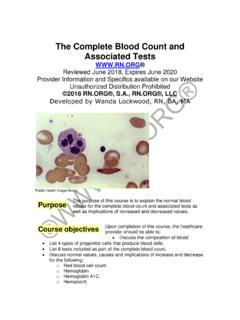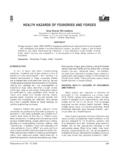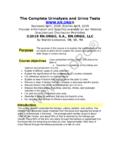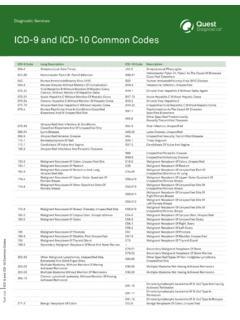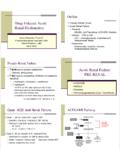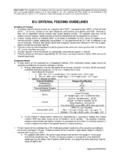Transcription of TheFriesian Diagnostics 101 - The Equine Blood Chemistry
1 TheFriesian16 Diagnostics 101 -The Equine Blood Chemistryby Katherine M. Fox, Fenway Foundation for Friesian Horseso Blood tests are an important part of the process by which veterinarians can assess the health and well being of their Equine patients. In the first part of this series, we took a look at the CBC (Complete Blood Count), identifying what cell types make up the CBC and what those values mean to all of us as we care for our horses. In this article, we will look at the second most common component of routine Blood work , the Equine Blood Chemistry panel. The Chemistry panel (also termed a profile ) requires drawing the Blood into a specific tube (serum separator tube) that contains a gel in the bottom, which will separate the cells from the fluid.
2 The Blood needs to fully clot in the tube (45-60 minutes to clot), after which the tube is centrifuged (spun) so that the cells move to the bottom of the tube and are separated from the fluid by the gel layer. The resulting liquid is called serum, a yellow colored fluid that contains electrolytes, enzymes, proteins, carbohydrates, and waste products of the body s metabolism. In a healthy horse, the body works to maintain itself in a steady, stable state called homeostasis, in which all components of the Blood are maintained in a relatively narrow range that we consider normal. A number of these Blood components change in specific and predictable ways when a horse is sick or injured that give us clues as to the source of the problem and help us to gauge a horse s treatment response and recovery.
3 When we interpret a horse s Blood Chemistry , we must think about all the factors that might influence our results. The collection and handling of the Blood , as well as the time lapse between the sampling and the processing, can affect the result of some of the commonly measured serum values. The lab at which the Blood is analyzed will have its own set of normal ranges, dependent on the equipment used, the type of test run, and the distribution of horse breeds whose Blood is sent to that lab (the relevant patient population), as well as many other factors. A horse s age, sex and breed also can have an impact on what normal might be. Because of the very nature of what we are measuring, some of the individual tests can have a wider degree of variability from horse to horse as well as across different breeds of horses, which can make them much more difficult to interpret.
4 Other values are minimally affected by these factors. 201317 AbbreviationWhat it Means:What Does it Tell Us?Chem PanelChemistry PanelAlso called a Chemistry Profile. A panel of tests done on serum that assesses organ funtion (kidney, liver, muscle, etc.) and general body (electrolyte)Sodium plays a role in water regulation in the body. Main source - the diet. Low sodium occurs with loss of sodium containing fluid (diarrhea or excessive sweating), some types of colic, ruptured bladder in a foal. High sodium is uncommon, seen with water (electrolyte)Elevated potassium values can be due to kidney dis-ease, metabolic disease, and muscle damage. High levels can be deadly. Low potassium is associated with a decreased dietary intake, loss from the GI tract (ex.)
5 Diarrhea), or changes in kidney (electrolyte)Chloride often changes as sodium changes, at the same time and in the same direction. Low CL can result from upper blockage that causes reflux (loss of fluid from the stomach).CaCalcium (mineral)Essential mineral for many systems in the body (skel-eton, enzymes, muscle, Blood and body regulation). High levels can be due to kidney failure, cancer, toxic levels of vitamin D, and poor nutrition. Low levels can be seen with conditions like lactation, acute kidney failure, and low (mineral)Phosphorus is found primarily in the bone and teeth, closely assoc. with Ca. The kidney removes excess phos-phorus. Changes in phosphorus levels can be caused by changes in dietary intake, a decrease in the ability of the kidneys to excrete it, or through hormonal imbalances that affect the level of Urea Nitrogen(from protein breakdown)Elevated levels are seen with conditios such as kidney failure, dehydration, heart disease, and bladder rupture.
6 Low levels might suggest excessive water intake, liver issues, or low levels of protein obtained from the (product of muscle metabolism)More specific test for kidney function. Kidneys are responsible for clearing creatinine from the body. Level is not affected by the diet or by liver function. Elevated levels can be due to kidney issues or severe, prolonged exercise (Cr originates in muscle but is not an indica-tor of muscle damage). A higher than normal creatinine may be seen with newborn foals and may be normal or indicate a birth or placenta related Phosphatase (enzyme)An enzyme found in a variety of tissues (liver, intestine, bone, placenta, kidneys and white Blood cells). Increased levels indicate increased production. Elevated most com-monly with liver and bone Amino-transferase(enzyme)An enzyme found in a variety of tissues (muscle, heart, red Blood cells, kidneys and liver).
7 Elevations can be seen with either muscle or liver damage. Highest levels of AST will be seen at approx. 24 hours after muscle may be clipped from magazine and laminated for reader s personal It Means:What Does it Tell Us?GGT Gamma-Glutamyl Transferase (enzyme)Found in the highest levels in the liver and kidney. Increased GGT is seen most often with liver Kinase (enzyme)Muscle enzyme that is elevated with muscle damage. Highest level will be seen 4-6 hours after injury. This enzyme will peak before Dehydrogenase (enzyme)Found in large amounts in many different organs and tissues. Is released from cells during organ/tissue damage. 5 different types of LDH exist. Increases of LDH are seen with liver, skel-etal muscle, heart muscle, and kidney Bilirubin (orange pigment)Pigment produced by the breakdown of hemoglobin, usually taken up by the liver.
8 Used to measure liver function. It is responsible for the yellow color known as jaundice. Can be increased with liver disease and when a horse is not eating, and in diseases in which red Blood cells are being destroyed (hemolysis).TPTotal Protein (protein)A measure of all of the proteins in the Blood (globulins and albumin). Elevated with dehydration and increased production of globulins (for ex. with chronic disease or cancer). Decreased levels are due to kidney or GI disease, liver failure or (protein)A type of Blood protein formed in the liver, important in main-taining the ratio of water and solids in the Blood (osmotic pres-sure). Increased albumin is seen with dehydration. A decrease can indicate liver disease, kidney or intestinal disease, some viral infections and decreased protein intake or (protein)Includes antibodies and proteins involved in Blood clotting and inflammation.
9 Important component of the immune system to fight RatioAlbumin to Globulin RatioCompares the ratio of Albumin to Globulin. Can be useful to differentiate between dehydration (both will be elevated) and disease (in which these two proteins can change independent of each other).tCO2 Total BicarbonateHelps to assess the changes that occur with respect to the acid-base balance of the body. The Blood needs to maintain it-self at a pH around ( is neutral) -tCO2 acts as a buffer system. An increase in tCO2 indicates a higher than desired pH (metabolic alkalosis), a decrease indicates a lower than desired pH (metabolic acidosis).GluGlucose (carbohydrate)A sugar easily measured in Blood . Elevated with a recent feed-ing, excitement, transportation, stress/pain (for ex.)
10 Colic), metabolic disease (Cushing s syndrome). Low levels are seen most often in foals that are sick/injured such that feed intake (mare s milk) is decreased and energy stores are quickly used up. FibrinogenType of plasma proteinInflammatory marker released by the body in response to injury and inflammation. Produced in the liver and important in clotting. Increased levels indicate acute or ongoing inflamma-tion. Decreased levels indicate decreased production by the liver or increased utilization of fibrinogen by the body during a disease process. May be found in higher levels in young foals and during 201319 The units used to measure the components of the Chemistry panel are weight per volume of Blood (grams, milligrams and micrograms per milliliter, deciliter or liter) for the solids like albumin and globulin, level of activity per volume of Blood (Units/liter) for the enzymes like ALP and CK, and milliequivalents/liter (mEq/L) of Blood for electrolytes like sodium and potassium.


